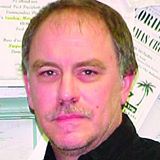Bioenergy touts composting at Seaford facility
Visitors offered info on recently approved anaerobic digester
SEAFORD — The importance of composting went public Saturday at the Bioenergy Innovation Center — home to long-running compost production and the future site for an anaerobic digester that will capture methane gas as marketable renewable energy.

You must be a member to read this story.
Join our family of readers for as little as $5 per month and support local, unbiased journalism.
Already a member? Log in to continue. Otherwise, follow the link below to join.
Please log in to continue |
Bioenergy touts composting at Seaford facility
Visitors offered info on recently approved anaerobic digester
SEAFORD — The importance of composting went public Saturday at the Bioenergy Innovation Center — home to long-running compost production and the future site for an anaerobic digester that will capture methane gas as marketable renewable energy.
Representatives of the Nanticoke Watershed Alliance and Delaware Masters Gardeners joined volunteers and BIC staff in the Discovery Day event that concluded International Compost Awareness Week.
“Compost, it’s a lot healthier for the environment,” said Seaford High School environmental science teacher/Future Farmers of America adviser Matt Cohee. “It’s not quite as high in nitrates, which get into our waterways.”
Sydney Williams, Nanticoke Watershed Alliance’s education coordinator, agreed.
“Not only does it divert food wastes from landfills, but it also creates an incredibly rich soil, … and that soil can actually replace synthetic fertilizer,” said Ms. Williams. “So as it rains, those synthetic fertilizers you use on your lawn can be washed off with the water and carried into waterways like the Nanticoke and eventually the (Chesapeake) Bay.”
Master Gardener Linda Peters said composting is great for gardens, too.
“Of course, we’re supporting composting as a great option for raising a better garden, as well as helping to keep the landfills from filling up,” said Ms. Peters, whose group is part of the University of Delaware/Delaware State University Cooperative Extension Program.
The event Saturday was part of Bioenergy DevCo’s outreach initiative.
“Our goal has always been to invite the community in to see what we do and how we do it, the importance of composting, the importance of being able to reuse, recycle and repurpose materials to the benefit of not only the community but the environment overall,” said Peter Ettinger, chief development officer for BDC.
“This ... (is) going to hopefully be one of even more open events now that we hope the pandemic is somewhere behind us,” he added. “So we’ll do this again and again. And what better way to celebrate mother Earth than by celebrating Mother’s Day!”
Visitors were offered a free plant or flower and the opportunity to scoop into a plastic container helpings of compost produced at BDC’s facility, the former Perdue AgriRecycle plant. It’s a mixture of chicken-processing byproducts and wood chips.
“They have been doing this process for a number of years,” said Jeff Deats, BIC’s facility manager. “Bioenergy just last year purchased the facility. ... They are continuing here with the composting operation, with plans for the future to also have an anaerobic-digestion unit.”
That anaerobic-digestion project has been a simmering issue, drawing opposition with environmental and traffic concerns. In April, it received the green light from Sussex County with council’s approval of BDC’s conditional-use request.
Mr. Cohee said anaerobic digestion as a viable solution to poultry wastes is a focus of his students.
“We had our (Advanced Placement) kids do a lot of research, whether this will be a good, positive impact on our environment or ecosystem. Ninety-five percent of the kids came to the conclusion that it was going to be a positive impact on our environment, that it was a better alternative with the poultry waste,” he said. “We looked at the pros and the cons. We looked at the people who were against this coming here. We watched the hearing, looking for the facts. And strictly based on the facts, 95% of the kids recommended this opportunity to go through.”
Anaerobic digestion will address the landfill issue, Mr. Cohee said.
“A lot of the DAF (dissolved air flotation material) is coming from the poultry plants itself. To be able (to) use that and looking at methane as a healthy alternative — that is not a fossil fuel — between the methane that we can get from a natural gas that is renewable and renewable compost we get out of it, it makes sense,” said Mr. Cohee. “We did research: Is methane more combustible than propane? We’ve got propane trucks going up and down the road. (Methane) is no more combustible than propane, so it’s a safe fuel source.”
Mr. Cohee said Seaford High School is looking to partner with BIC in other ways.
“They are doing an outstanding job purifying the water before it goes back into the environment,” he said. “We’re trying to get some hands-on opportunities for our kids, possibly some job opportunities. And we’re looking at possibly doing summer internships next year.”
Mr. Deats said DAF materials — typically fats, oils and greases from poultry processing — in raw form are very odorous and a rather unpleasant substance.
“But through composting, what we generate here, it has no odor, and it has been broken down naturally through a natural process into nutrients that plants can utilize. The addition of the anaerobic digester will just be complementing that,” he said. “We will still be making compost, but now what’s going to happen is that same DAF material that goes into the compost now will be fed into the anaerobic digester first, and it will be partially broken down. The benefit the anaerobic digester does is it is totally all-contained. Anaerobic digestion generates a gas, which can then be used for energy. So it’s kind of a free energy source. Then, the sludge material that comes out of that, the solids can be taken off the digester and made into compost.”

 By
By 



